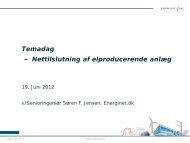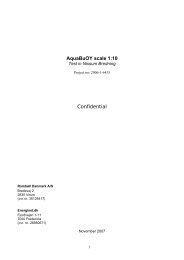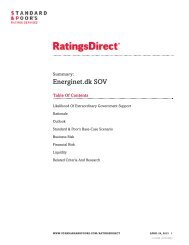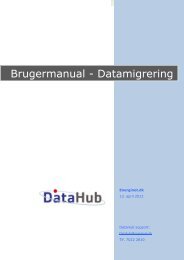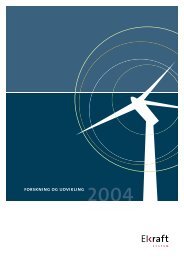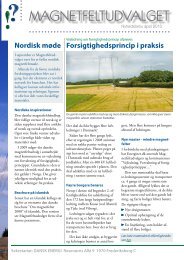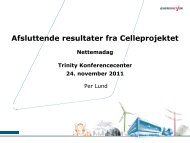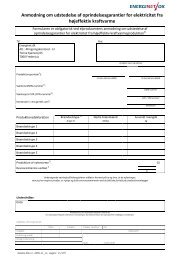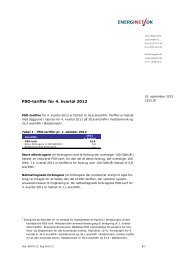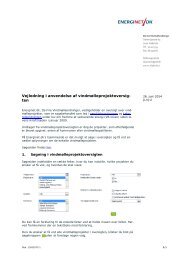smart griD IN DENmARK 2.0 - Energinet.dk
smart griD IN DENmARK 2.0 - Energinet.dk
smart griD IN DENmARK 2.0 - Energinet.dk
- No tags were found...
Create successful ePaper yourself
Turn your PDF publications into a flip-book with our unique Google optimized e-Paper software.
<strong>smart</strong> grid <strong>IN</strong> DENMARK <strong>2.0</strong> | 5// SUMMARYIn 2011, the Smart Grid Network, set up by the Danish Minister for Climate and Energyin 2010, published a report that points to 35 recommendations which each contributeto establishing a Smart Grid in Denmark. This report has been prepared by the DanishEnergy Association and <strong>Energinet</strong>.<strong>dk</strong> and looks at three of these recommendations ingreater detail:Concept for power system operation (Smart Grid Network recommendation no. 22)Information model for data communication (Smart Grid Network recommendation no. 23)Road map for roll-out of the Smart Grid (Smart Grid Network recommendation no. 24)SMART GRID CONCEPT<strong>Energinet</strong>.<strong>dk</strong> and the Danish Energy Association havejointly developed a Smart Grid concept which canbe used to mobilise and activate flexible electricityconsumption and production from small customers– flexibility that would otherwise have remained unutilisedin the power system.With the establishment of a Smart Grid conceptcomes an invitation to suppliers and other players todevelop new solutions and products to support theconcept.The concept mobilises and activates flexible electricityconsumption and production from smallcustomers. This happens through customers or appliancesconnected to the power system changingtheir behaviour – as and when requested – to fulfilthe needs of the power system. For example, a heatpump might stop because a power line is overloaded,or an electric car adapts its charging pattern to balanceout fluctuating wind power or solar energy levels.This flexibility is sought by grid companies to reduceand defer investments in the distribution grids andby <strong>Energinet</strong>.<strong>dk</strong> (the transmission system operator,TSO) to balance the entire power system.Commercial players handle the flexibility, and competeon equal terms to deliver the most efficientand innovative product. The commercial players willprobably gather a sufficient volume of flexibility andoffer it to grid companies and <strong>Energinet</strong>.<strong>dk</strong>, which areexpected to only want to contact a limited number ofplaces in order to mobilise and activate the flexibleelectricity consumption and production.The concept distinguishes between two differentmechanisms for activating flexibility. The first is theuse of price signals (variable grid tariffs and electricityprices), which give customers a financial incentiveto shift their electricity consumption and productionto times of day when it is less inconvenient forthe power system. The second is flexibility products,where a pre-arranged and clearly specified service –for example reducing the load in a particular grid area– can be activated as required by the grid companiesand/or <strong>Energinet</strong>.<strong>dk</strong> for an agreed price.The use of price signals is an important element inreleasing the value of flexible electricity consumptionand production, but it is not enough on its own asthe response to the price signals cannot be guaranteedin advance. Trading in flexibility products is thesupplementary measure which ensures that specificneeds for flexibility can be met at all times.The aim of the concept is, therefore, the establishmentin the long term of a fully functional market fortrading in standardised flexibility products. To beginwith, the trading in flexibility is expected to take placebilaterally, and for a transitional period via a simplemarket place acting as a display window for confirmedflexibility agreements.The concept ties in well with the act which has recentlybeen passed on the so-called wholesale model,which defines the future distribution of roles inthe electricity market where the grid companies arenot in direct contact with individual customers. Theproposed concept therefore does not require a directbusiness connection between grid companies andcustomers as the flexibility will be exploited via thecommercial players.



